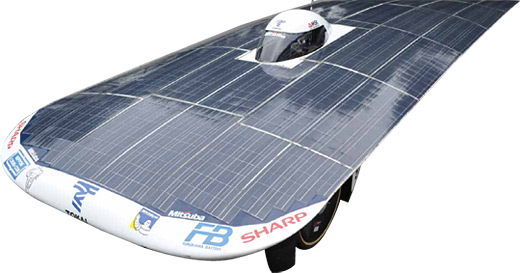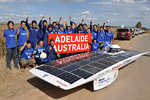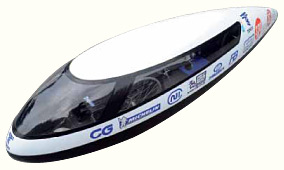

Electronics Technical Hub > Technical Reference Online > The Ultimate Energy-Conscious Vehicle
The Ultimate Energy-Conscious Vehicle


Tokai University team wins the world's largest solar car race!
Tokai University solar car is the first car to cross the finish line in the 3,000km-journey "Global Green Challenge" solar car race!
"Educational aspect in developing PV vehicles is to learn about the environmentally friendly motor-car, and to nurture the competitiveness of engineers or business people through the car rally,"
Professor Hideki Kimura
An academic team of Professor Hideki Kimura’s in Tokai University is focusing on environmentally-friendly vehicle production which is scheduled to join a 3000km car rally in 2009, travelling down through Australia using a photovoltaic (PV) electric motor.

This is a follow up to the win of a 4200km race around Republic of South Africa in 2008. The car rally is useful for nurturing business people or engineers in furthering their technical education, while enhancing their teamwork capability. "Educational aspect in developing PV vehicles is to learn about the environmentally friendly motor-car, and to nurture the competitiveness of engineers or business people through the car rally" Professor Kimura said. Electric vehicles and fuel cell cars do not produce carbon dioxide (CO2) as exhaust fumes, but produce CO2 to charge electricity as the energy source or hydrogen gas as the fuel. Photovoltaic cell, however, does not exhaust CO2 once it is produced. The PV vehicle is the ultimate environmentally-friendly car working with only natural energy. Environmental technology is an important topic for the future and its educational value is thus significant.
It is also important to nurture teamwork. Human relations, human networking and teamwork are especially important after graduating from the university. Company recruiters are not interested in students just achieving high performance in their school curriculum.
Struggling PV Vehicle Prototype
Tokai university team joined eleven other teams in a tough rally of 4200km running around Republic of South Africa during September 28th to October 8th in 2008, and won the race. Four drivers took turns to drive in the rally. One of the drivers was Kenichiro Shinozuka, who had won the Paris-Dakar Rally previously.
Tokai team had purchased or had been given the photovoltaic cell panel, an energy source of the PV vehicle (see main image), from PV manufacturers. All PV cells are made of single silicon crystal. The event regulation limited the size of the PV panel; the maximum area is under 8 square metres. Performance of the PV cells had been boosted annually, and the area has been limited to be up to 6 square meters since 2007, to reduce PV vehicle' s velocity.
Open output voltage of the solar cell is approximately 0.5V for silicon crystals. The PV cells should be connected in series to boost the output voltage. Approximately 120V is obtained by connecting eight panels in series, with each panel having 32 to 36 cells in series connection. This is because the output voltage is near the commercial 100V power supply, Professor Kimura commented. Many electric components are commercially available near the commercial power supply voltage.
Technology Based on Electric Vehicle
PV rally's vehicle uses solar power as its energy source, but the technology is based on electric vehicle, especially for the motor drive and control circuits, as well as the tires with lower rolling resistance. To reduce air resistance of the car body, they make use of three dimensional CAD and fluid dynamic simulator, while three wheels are designed to lighten the body.
Faraday Magic 2, an electric car (see image on the bottom) is a five time winner from 2004 to 2008, at World Econo Move, an energy-saving race which judges on the distance a vehicle runs in two hours with a lead battery of 144Wh energy. The winning car completed 90km and consumed 72W per hour on average. Since a horse power corresponds to 736W, this means 72W is approximately equivalent to 0.1 horse power.
Faraday Magic 2, an electric car

The motor drive system drives a three-phase motor with an inverter through DC power supply, and the SPM (surface permanent magnet) motor combines permanent magnet with an electromagnet, the same mechanism found in current hybrid cars. They develop amorphous ferromagnetic cores to boost the conversion efficiency, and handed it to motor manufacturers of Mistuba Corp. or Tokushu Denso Co., Ltd. to produce prototypes of the motor (see image on the bottom). Professor Kimura said that raising efficiency is the first priority even if they must put in additional work. The higher efficiency corresponds to less heat generation, and so requires no cooling fan, which leads to a lighter body, and less energy requirement.
prototypes of the motor

In the EV motor control, a PIC microcontroller from Microchip Technology Inc. controls the phase advance and PWM with synchronous rectification to boost efficiency.
The phase advance is similar to the spark advance in an engine control system, which boost motor rotation cycles with advanced turn-on timing. The synchronous rectification is used in case of lower motor rotation with chopping, and prevents from larger losses at smaller duty ratios of the PWM. Power MOSFETs are used in the final stage due to relative low voltage. A MOSFET is more suitable rather than IGBT in lower voltage applications because of higher efficiency. The motor control system reaches over 96% efficiency.
Simultaneous Usage of Li-ion Battery and PV
In the rally, the energy source is not only the solar power. Lithium ion battery is used as an auxiliary energy. Li-ion battery has a capacity of 5kWh, capable of running for three hours. The solar rally starts from 8:00 am and ends at 5:00 pm. The team charges the Li-ion battery during the rest of the sun-rising time, tilting the PV panel to the direction of the sun. The PV panel can be removed easily from the vehicle. In the solar car rally, two support cars are needed. They are positioned at front and the rear of the PV racing car. The rear support car sends a lot of information to the PV car driver, including its current location using the GPS system, the distance to the destination, and gradient information. The other support car measures voltages and currents of the PV panel using a telemetry system, and receives climate data from the Himawari climate satellite, as well as voice data using a communication satellite of Inmarsat BGAN service which is available even in a desert where mobile phone services are not available.
"To win the rally, speed control is essential" Professor Kimura said. For example, air resistance increases with square of the velocity, and power consumption with cubic of the velocity. The velocity should be kept constant and even optimized, depending on the climate condition of rain and wind, or the road condition such as a steep slope. The Li-ion battery is applied for acceleration or during windy and rainy days, along with the solar energy. This means it must be used moderately. The support car sometimes issues instruction of accelerating or decelerating, and talks to the driver to prevent him from sleeping.
For the coming Australian rally from Darwin to Adelaide at end of October 2009, Sharp Corp. announced in this June, to offer a compound semiconductor PV panel to the Tokai University team, rather than silicon solar panel. The higher performance solar panel has 30% conversion efficiency and 1.8kW power. With the new solar panel, the team aims to win the race, competing against other global teams.











